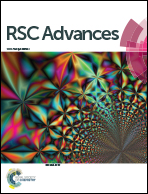Bioinspired polymeric pigments to mimic natural hair coloring†
Abstract
Due to an increasingly aging population, hair dyeing has become more necessary in daily life; however synthetic hair dyes often have the disadvantages of harsh dyeing conditions, a slow dyeing process and biological toxicity. Herein, we developed a bioinspired approach to mimic the natural hair dyeing process under mild conditions. Compared to the existing polydopamine deposition approach with harsh conditions, mild conditions and effective deposition were achieved here. First, in the presence of tyrosine hydroxylase and metal ions, dopamine could be oxidized into polydopamine, a mimic of human eumelanin, and then self-assembled into nanometer-scale pigments. Through optimizing the experimental parameters, various colors and the desired darkness could be achieved within less than 1 minute. In addition, significant durability was observed after continuous washing with polydopamine assemblies as hair dyes. Morphological analysis was applied to verify the deposition of polydopamine assemblies onto the hair surface, which induces the hair color change. Also, animal studies were conducted to evaluate the efficiency and biological toxicity of this approach. Overall, this bioinspired approach could provide a new avenue for biocompatible and effective nanomaterial-based hair dyes for at-home use.



 Please wait while we load your content...
Please wait while we load your content...